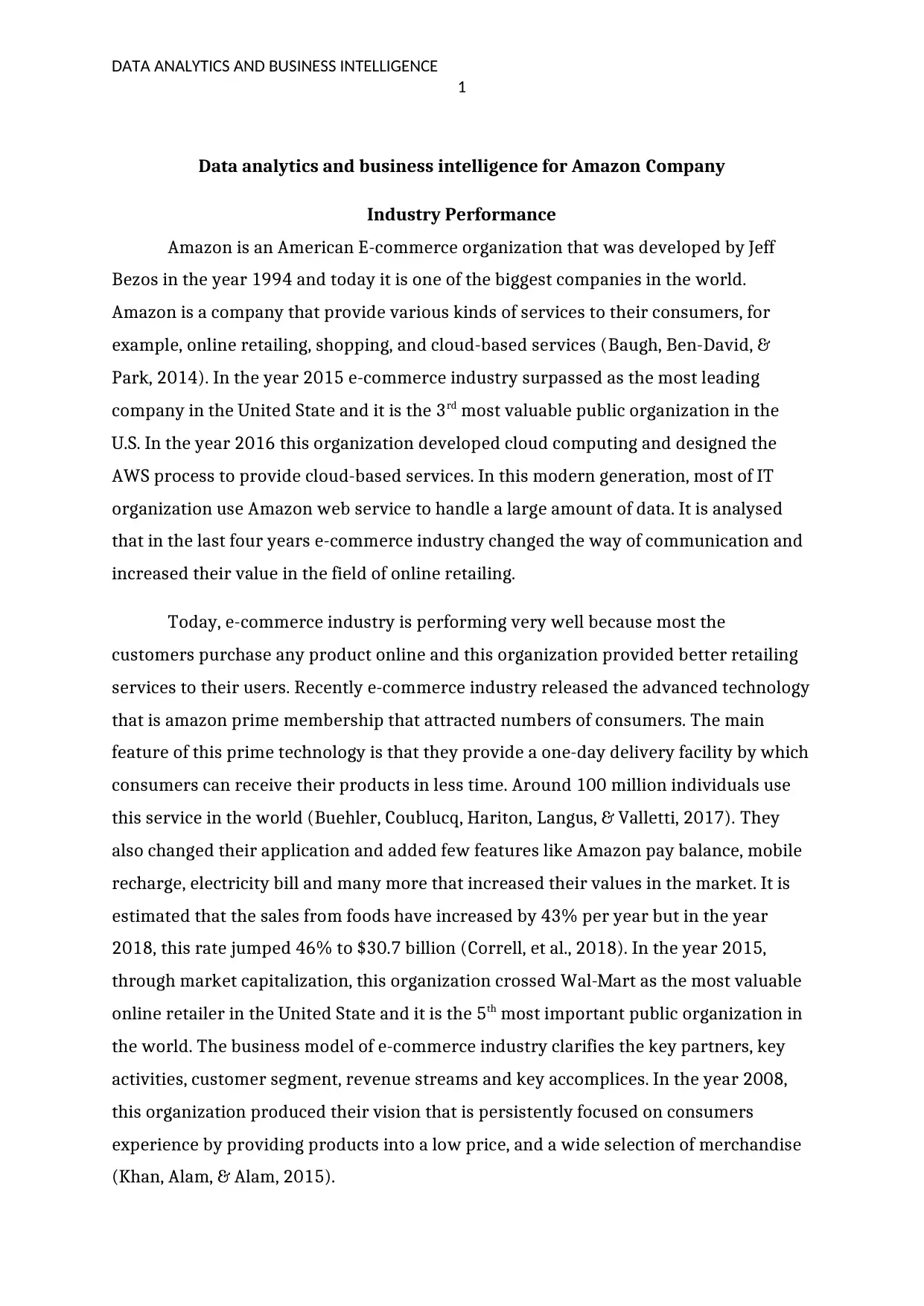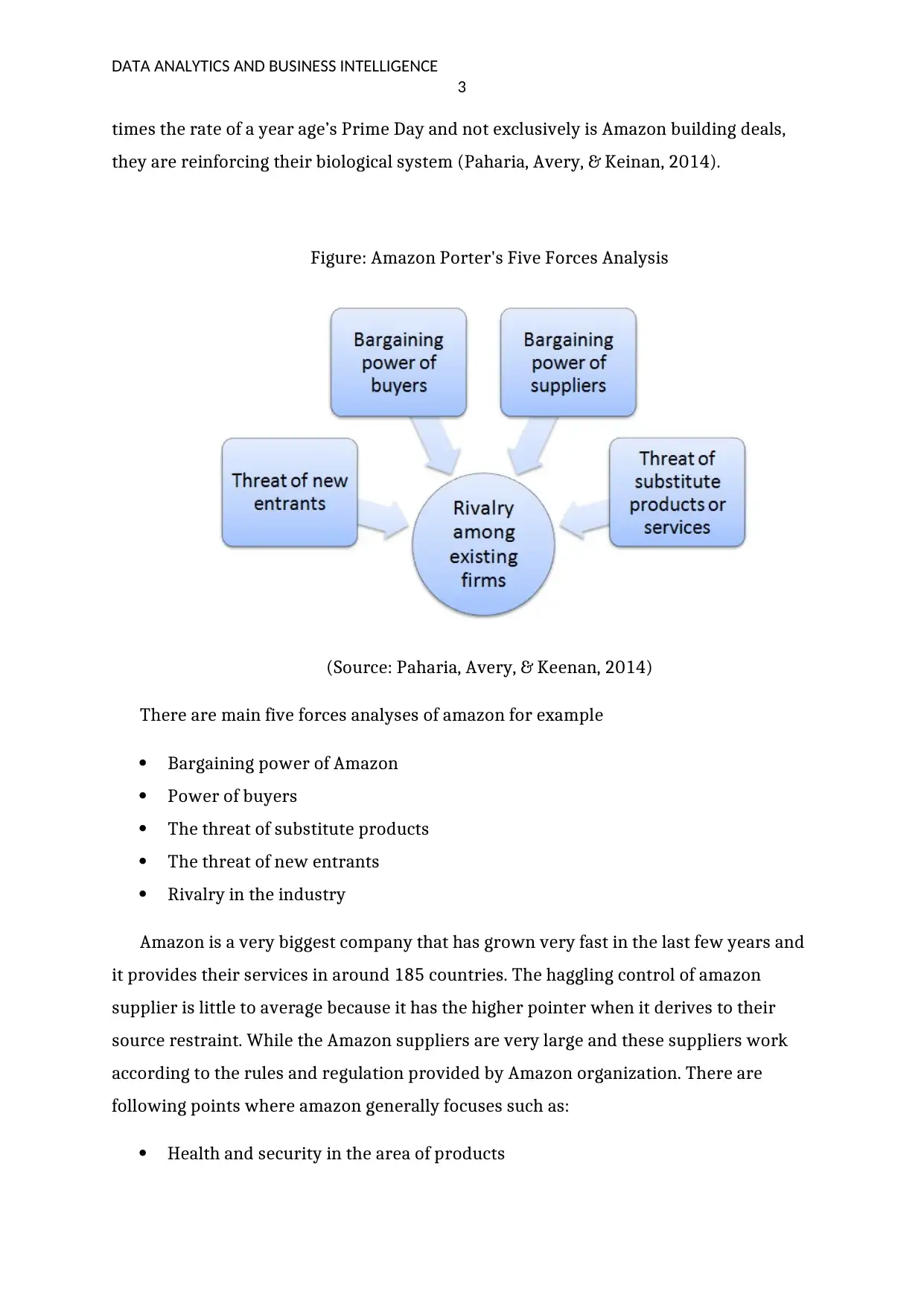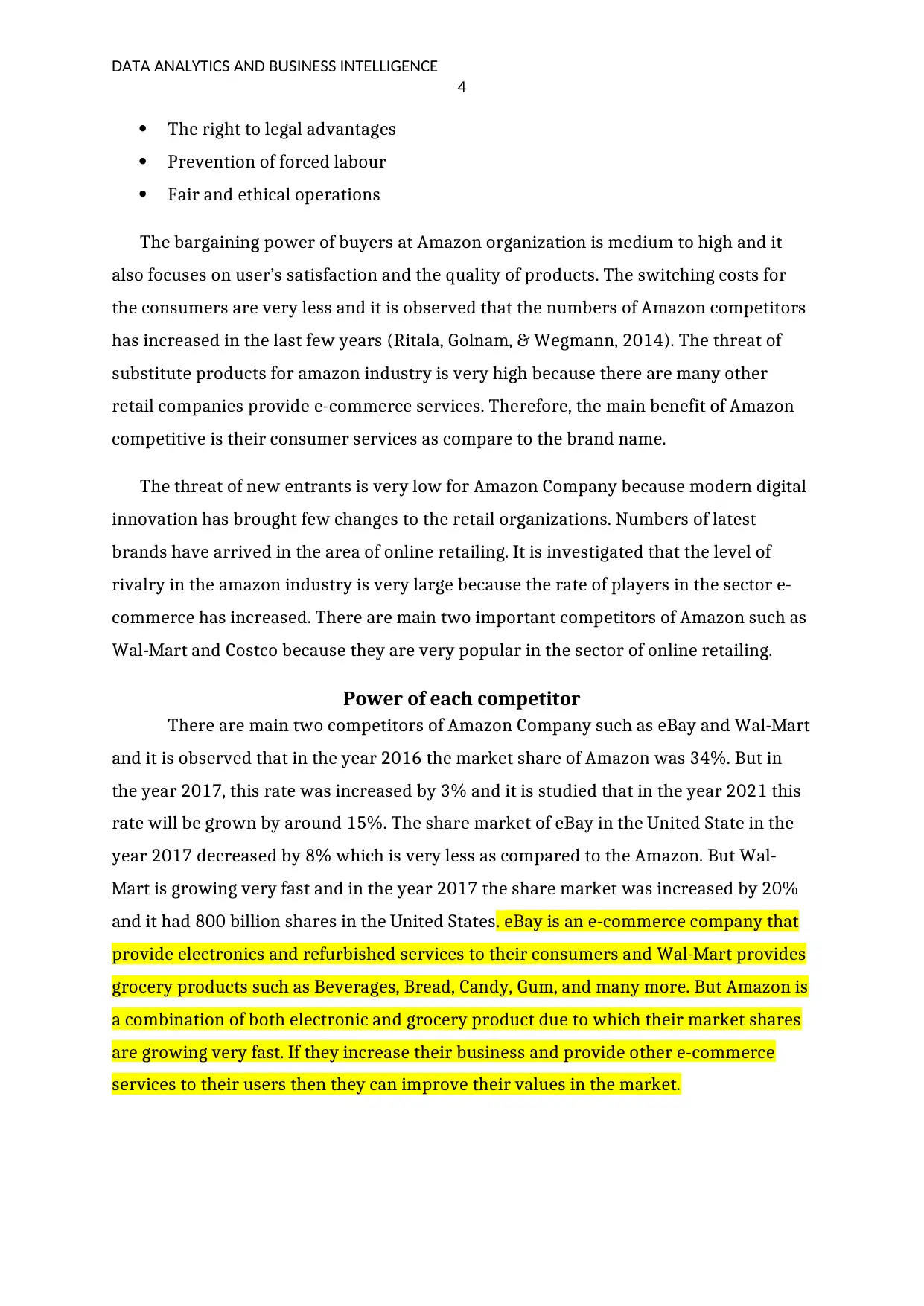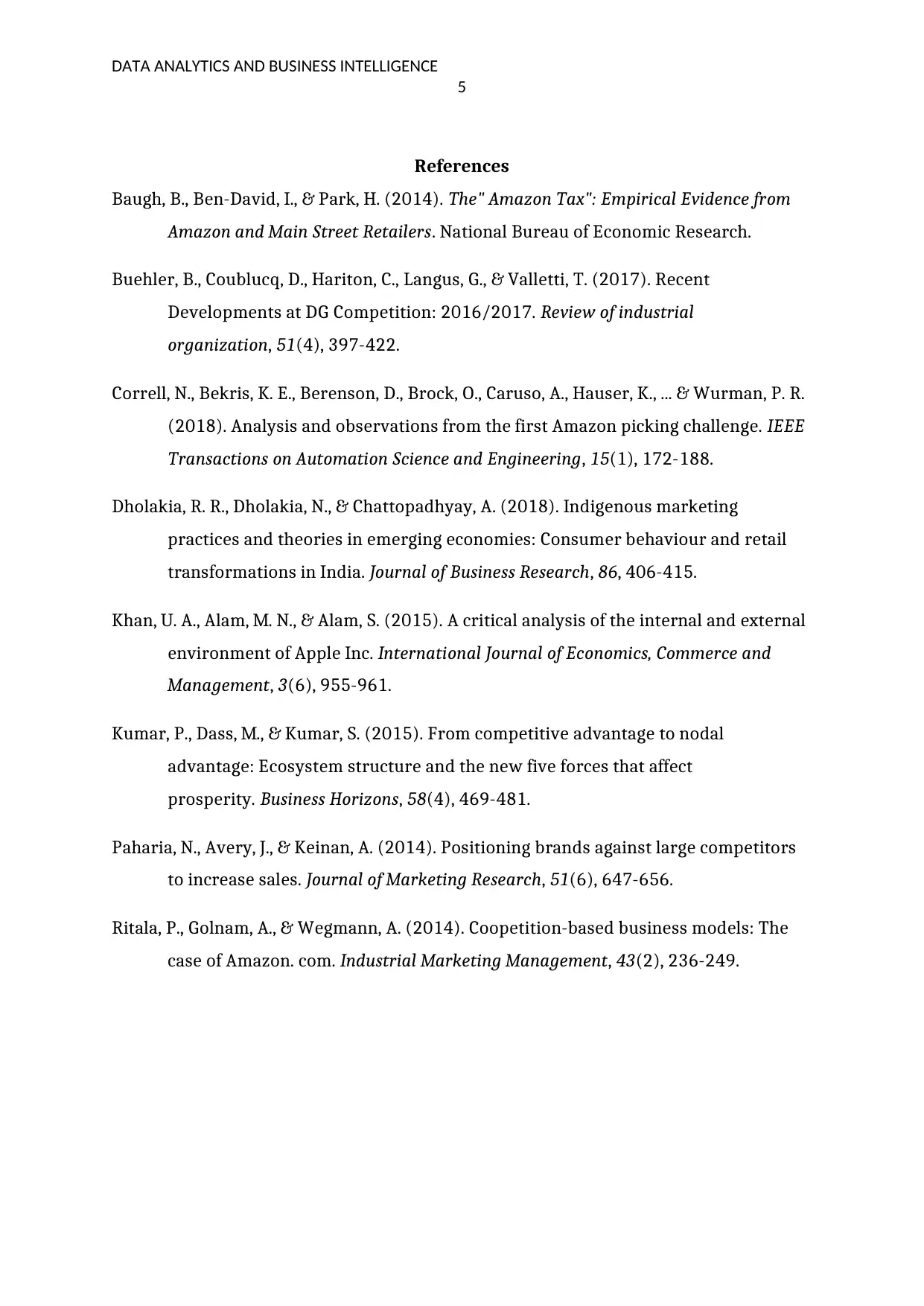Analyzing Amazon's Data Analytics and Business Intelligence
VerifiedAdded on 2023/05/31
|6
|1906
|493
Report
AI Summary
This report provides a detailed analysis of Amazon's data analytics and business intelligence strategies within the e-commerce industry. It begins by outlining Amazon's industry performance, highlighting its growth and dominance, particularly with services like Amazon Prime. The report identifies key players in the e-commerce sector, including eBay and Walmart, and compares their market share and competitive strategies. A Porter's Five Forces analysis is used to evaluate Amazon's competitive environment, considering factors such as bargaining power, the threat of substitutes, and new entrants. The report concludes by examining the power of each competitor and emphasizing Amazon's strong position due to its combination of diverse product offerings and superior customer service. Desklib provides this document as a valuable resource for students.

DATA ANALYTICS AND BUSINESS INTELLIGENCE
0
Data Analysis and Business
Intelligence
0
Data Analysis and Business
Intelligence
Paraphrase This Document
Need a fresh take? Get an instant paraphrase of this document with our AI Paraphraser

DATA ANALYTICS AND BUSINESS INTELLIGENCE
1
Data analytics and business intelligence for Amazon Company
Industry Performance
Amazon is an American E-commerce organization that was developed by Jeff
Bezos in the year 1994 and today it is one of the biggest companies in the world.
Amazon is a company that provide various kinds of services to their consumers, for
example, online retailing, shopping, and cloud-based services (Baugh, Ben-David, &
Park, 2014). In the year 2015 e-commerce industry surpassed as the most leading
company in the United State and it is the 3rd most valuable public organization in the
U.S. In the year 2016 this organization developed cloud computing and designed the
AWS process to provide cloud-based services. In this modern generation, most of IT
organization use Amazon web service to handle a large amount of data. It is analysed
that in the last four years e-commerce industry changed the way of communication and
increased their value in the field of online retailing.
Today, e-commerce industry is performing very well because most the
customers purchase any product online and this organization provided better retailing
services to their users. Recently e-commerce industry released the advanced technology
that is amazon prime membership that attracted numbers of consumers. The main
feature of this prime technology is that they provide a one-day delivery facility by which
consumers can receive their products in less time. Around 100 million individuals use
this service in the world (Buehler, Coublucq, Hariton, Langus, & Valletti, 2017). They
also changed their application and added few features like Amazon pay balance, mobile
recharge, electricity bill and many more that increased their values in the market. It is
estimated that the sales from foods have increased by 43% per year but in the year
2018, this rate jumped 46% to $30.7 billion (Correll, et al., 2018). In the year 2015,
through market capitalization, this organization crossed Wal-Mart as the most valuable
online retailer in the United State and it is the 5th most important public organization in
the world. The business model of e-commerce industry clarifies the key partners, key
activities, customer segment, revenue streams and key accomplices. In the year 2008,
this organization produced their vision that is persistently focused on consumers
experience by providing products into a low price, and a wide selection of merchandise
(Khan, Alam, & Alam, 2015).
1
Data analytics and business intelligence for Amazon Company
Industry Performance
Amazon is an American E-commerce organization that was developed by Jeff
Bezos in the year 1994 and today it is one of the biggest companies in the world.
Amazon is a company that provide various kinds of services to their consumers, for
example, online retailing, shopping, and cloud-based services (Baugh, Ben-David, &
Park, 2014). In the year 2015 e-commerce industry surpassed as the most leading
company in the United State and it is the 3rd most valuable public organization in the
U.S. In the year 2016 this organization developed cloud computing and designed the
AWS process to provide cloud-based services. In this modern generation, most of IT
organization use Amazon web service to handle a large amount of data. It is analysed
that in the last four years e-commerce industry changed the way of communication and
increased their value in the field of online retailing.
Today, e-commerce industry is performing very well because most the
customers purchase any product online and this organization provided better retailing
services to their users. Recently e-commerce industry released the advanced technology
that is amazon prime membership that attracted numbers of consumers. The main
feature of this prime technology is that they provide a one-day delivery facility by which
consumers can receive their products in less time. Around 100 million individuals use
this service in the world (Buehler, Coublucq, Hariton, Langus, & Valletti, 2017). They
also changed their application and added few features like Amazon pay balance, mobile
recharge, electricity bill and many more that increased their values in the market. It is
estimated that the sales from foods have increased by 43% per year but in the year
2018, this rate jumped 46% to $30.7 billion (Correll, et al., 2018). In the year 2015,
through market capitalization, this organization crossed Wal-Mart as the most valuable
online retailer in the United State and it is the 5th most important public organization in
the world. The business model of e-commerce industry clarifies the key partners, key
activities, customer segment, revenue streams and key accomplices. In the year 2008,
this organization produced their vision that is persistently focused on consumers
experience by providing products into a low price, and a wide selection of merchandise
(Khan, Alam, & Alam, 2015).

DATA ANALYTICS AND BUSINESS INTELLIGENCE
2
Main Players
Amazon is an online retail company which is a 3rd most valuable company in the
United States but there are many players in this sector, for example, eBay, Wal-Mart,
wish.com, Costco Wholesale Corporation and Kroger Company. According to a recent
survey it is identified that Amazon is one of the biggest players in the sector of E-
commerce and it also provided web services to their consumers. All these originations
are ranked according to the sale figures and financial statements and Wal-Mart is the
world largest retail industry after Amazon that reported revenue of $485.7 billion in the
year 2015 (Dholakia, Dholakia, & Chattopadhyay, 2018). It operates almost 11,453
stores in total 27 countries but recently Amazon increased their market and around
12,400 stores operated in around 29 countries. The Costco wholesale is also an online
retailer that operates in only 9 countries and it reported revenue of $112.5 billion in the
year 2914 which is very less as compared to the Amazon industry. It is investigated that
Amazon is the leader in the area of the retailer and other e-commerce industries are not
close to the volume of Amazon. eBay has around 6.5% of the market, Wal-Mart has
3.7%, best buy has 1.3% but Amazon has 7.9% which is very high as compare to other
(Kumar, Dass, & Kumar, 2015).
Competing Environment
Amazon is the biggest e-commerce organization through revenue in the U.S. as of
the year 2017. This organization generally operates in the main three general segments,
for example, media, electronics and merchandise. Oligopoly is one major kind of
competition exists in the E-commerce industry and Amazon is leading the competition
as their products and services offering are huge through which they target a larger part
of the target market. In the media segments, there are several competitors of Amazon
such as eBay, Netflix, Time Warner cable, Apple, and Google. In the sector of electronic,
there are many competitors, for example, best buy, family dollar, WMT, BIG, and
systeMacs (Kumar, Dass, & Kumar, 2015). In the third segment, Amazon competes with
few of the world biggest companies involving CDW, CNXW, NSIT, ORCL, and CTXS.
Amazon generally focuses on the selling books and also provides cloud-based services
to their consumers. The online retailer's development is being driven by that of Amazon
Prime, which presently purportedly has half of the American families. Add to that the
quick infiltration of Alexa driven man-made reasoning (AI) gadgets, which sold at seven
2
Main Players
Amazon is an online retail company which is a 3rd most valuable company in the
United States but there are many players in this sector, for example, eBay, Wal-Mart,
wish.com, Costco Wholesale Corporation and Kroger Company. According to a recent
survey it is identified that Amazon is one of the biggest players in the sector of E-
commerce and it also provided web services to their consumers. All these originations
are ranked according to the sale figures and financial statements and Wal-Mart is the
world largest retail industry after Amazon that reported revenue of $485.7 billion in the
year 2015 (Dholakia, Dholakia, & Chattopadhyay, 2018). It operates almost 11,453
stores in total 27 countries but recently Amazon increased their market and around
12,400 stores operated in around 29 countries. The Costco wholesale is also an online
retailer that operates in only 9 countries and it reported revenue of $112.5 billion in the
year 2914 which is very less as compared to the Amazon industry. It is investigated that
Amazon is the leader in the area of the retailer and other e-commerce industries are not
close to the volume of Amazon. eBay has around 6.5% of the market, Wal-Mart has
3.7%, best buy has 1.3% but Amazon has 7.9% which is very high as compare to other
(Kumar, Dass, & Kumar, 2015).
Competing Environment
Amazon is the biggest e-commerce organization through revenue in the U.S. as of
the year 2017. This organization generally operates in the main three general segments,
for example, media, electronics and merchandise. Oligopoly is one major kind of
competition exists in the E-commerce industry and Amazon is leading the competition
as their products and services offering are huge through which they target a larger part
of the target market. In the media segments, there are several competitors of Amazon
such as eBay, Netflix, Time Warner cable, Apple, and Google. In the sector of electronic,
there are many competitors, for example, best buy, family dollar, WMT, BIG, and
systeMacs (Kumar, Dass, & Kumar, 2015). In the third segment, Amazon competes with
few of the world biggest companies involving CDW, CNXW, NSIT, ORCL, and CTXS.
Amazon generally focuses on the selling books and also provides cloud-based services
to their consumers. The online retailer's development is being driven by that of Amazon
Prime, which presently purportedly has half of the American families. Add to that the
quick infiltration of Alexa driven man-made reasoning (AI) gadgets, which sold at seven
⊘ This is a preview!⊘
Do you want full access?
Subscribe today to unlock all pages.

Trusted by 1+ million students worldwide

DATA ANALYTICS AND BUSINESS INTELLIGENCE
3
times the rate of a year age’s Prime Day and not exclusively is Amazon building deals,
they are reinforcing their biological system (Paharia, Avery, & Keinan, 2014).
Figure: Amazon Porter's Five Forces Analysis
(Source: Paharia, Avery, & Keenan, 2014)
There are main five forces analyses of amazon for example
Bargaining power of Amazon
Power of buyers
The threat of substitute products
The threat of new entrants
Rivalry in the industry
Amazon is a very biggest company that has grown very fast in the last few years and
it provides their services in around 185 countries. The haggling control of amazon
supplier is little to average because it has the higher pointer when it derives to their
source restraint. While the Amazon suppliers are very large and these suppliers work
according to the rules and regulation provided by Amazon organization. There are
following points where amazon generally focuses such as:
Health and security in the area of products
3
times the rate of a year age’s Prime Day and not exclusively is Amazon building deals,
they are reinforcing their biological system (Paharia, Avery, & Keinan, 2014).
Figure: Amazon Porter's Five Forces Analysis
(Source: Paharia, Avery, & Keenan, 2014)
There are main five forces analyses of amazon for example
Bargaining power of Amazon
Power of buyers
The threat of substitute products
The threat of new entrants
Rivalry in the industry
Amazon is a very biggest company that has grown very fast in the last few years and
it provides their services in around 185 countries. The haggling control of amazon
supplier is little to average because it has the higher pointer when it derives to their
source restraint. While the Amazon suppliers are very large and these suppliers work
according to the rules and regulation provided by Amazon organization. There are
following points where amazon generally focuses such as:
Health and security in the area of products
Paraphrase This Document
Need a fresh take? Get an instant paraphrase of this document with our AI Paraphraser

DATA ANALYTICS AND BUSINESS INTELLIGENCE
4
The right to legal advantages
Prevention of forced labour
Fair and ethical operations
The bargaining power of buyers at Amazon organization is medium to high and it
also focuses on user’s satisfaction and the quality of products. The switching costs for
the consumers are very less and it is observed that the numbers of Amazon competitors
has increased in the last few years (Ritala, Golnam, & Wegmann, 2014). The threat of
substitute products for amazon industry is very high because there are many other
retail companies provide e-commerce services. Therefore, the main benefit of Amazon
competitive is their consumer services as compare to the brand name.
The threat of new entrants is very low for Amazon Company because modern digital
innovation has brought few changes to the retail organizations. Numbers of latest
brands have arrived in the area of online retailing. It is investigated that the level of
rivalry in the amazon industry is very large because the rate of players in the sector e-
commerce has increased. There are main two important competitors of Amazon such as
Wal-Mart and Costco because they are very popular in the sector of online retailing.
Power of each competitor
There are main two competitors of Amazon Company such as eBay and Wal-Mart
and it is observed that in the year 2016 the market share of Amazon was 34%. But in
the year 2017, this rate was increased by 3% and it is studied that in the year 2021 this
rate will be grown by around 15%. The share market of eBay in the United State in the
year 2017 decreased by 8% which is very less as compared to the Amazon. But Wal-
Mart is growing very fast and in the year 2017 the share market was increased by 20%
and it had 800 billion shares in the United States. eBay is an e-commerce company that
provide electronics and refurbished services to their consumers and Wal-Mart provides
grocery products such as Beverages, Bread, Candy, Gum, and many more. But Amazon is
a combination of both electronic and grocery product due to which their market shares
are growing very fast. If they increase their business and provide other e-commerce
services to their users then they can improve their values in the market.
4
The right to legal advantages
Prevention of forced labour
Fair and ethical operations
The bargaining power of buyers at Amazon organization is medium to high and it
also focuses on user’s satisfaction and the quality of products. The switching costs for
the consumers are very less and it is observed that the numbers of Amazon competitors
has increased in the last few years (Ritala, Golnam, & Wegmann, 2014). The threat of
substitute products for amazon industry is very high because there are many other
retail companies provide e-commerce services. Therefore, the main benefit of Amazon
competitive is their consumer services as compare to the brand name.
The threat of new entrants is very low for Amazon Company because modern digital
innovation has brought few changes to the retail organizations. Numbers of latest
brands have arrived in the area of online retailing. It is investigated that the level of
rivalry in the amazon industry is very large because the rate of players in the sector e-
commerce has increased. There are main two important competitors of Amazon such as
Wal-Mart and Costco because they are very popular in the sector of online retailing.
Power of each competitor
There are main two competitors of Amazon Company such as eBay and Wal-Mart
and it is observed that in the year 2016 the market share of Amazon was 34%. But in
the year 2017, this rate was increased by 3% and it is studied that in the year 2021 this
rate will be grown by around 15%. The share market of eBay in the United State in the
year 2017 decreased by 8% which is very less as compared to the Amazon. But Wal-
Mart is growing very fast and in the year 2017 the share market was increased by 20%
and it had 800 billion shares in the United States. eBay is an e-commerce company that
provide electronics and refurbished services to their consumers and Wal-Mart provides
grocery products such as Beverages, Bread, Candy, Gum, and many more. But Amazon is
a combination of both electronic and grocery product due to which their market shares
are growing very fast. If they increase their business and provide other e-commerce
services to their users then they can improve their values in the market.

DATA ANALYTICS AND BUSINESS INTELLIGENCE
5
References
Baugh, B., Ben-David, I., & Park, H. (2014). The" Amazon Tax": Empirical Evidence from
Amazon and Main Street Retailers. National Bureau of Economic Research.
Buehler, B., Coublucq, D., Hariton, C., Langus, G., & Valletti, T. (2017). Recent
Developments at DG Competition: 2016/2017. Review of industrial
organization, 51(4), 397-422.
Correll, N., Bekris, K. E., Berenson, D., Brock, O., Caruso, A., Hauser, K., ... & Wurman, P. R.
(2018). Analysis and observations from the first Amazon picking challenge. IEEE
Transactions on Automation Science and Engineering, 15(1), 172-188.
Dholakia, R. R., Dholakia, N., & Chattopadhyay, A. (2018). Indigenous marketing
practices and theories in emerging economies: Consumer behaviour and retail
transformations in India. Journal of Business Research, 86, 406-415.
Khan, U. A., Alam, M. N., & Alam, S. (2015). A critical analysis of the internal and external
environment of Apple Inc. International Journal of Economics, Commerce and
Management, 3(6), 955-961.
Kumar, P., Dass, M., & Kumar, S. (2015). From competitive advantage to nodal
advantage: Ecosystem structure and the new five forces that affect
prosperity. Business Horizons, 58(4), 469-481.
Paharia, N., Avery, J., & Keinan, A. (2014). Positioning brands against large competitors
to increase sales. Journal of Marketing Research, 51(6), 647-656.
Ritala, P., Golnam, A., & Wegmann, A. (2014). Coopetition-based business models: The
case of Amazon. com. Industrial Marketing Management, 43(2), 236-249.
5
References
Baugh, B., Ben-David, I., & Park, H. (2014). The" Amazon Tax": Empirical Evidence from
Amazon and Main Street Retailers. National Bureau of Economic Research.
Buehler, B., Coublucq, D., Hariton, C., Langus, G., & Valletti, T. (2017). Recent
Developments at DG Competition: 2016/2017. Review of industrial
organization, 51(4), 397-422.
Correll, N., Bekris, K. E., Berenson, D., Brock, O., Caruso, A., Hauser, K., ... & Wurman, P. R.
(2018). Analysis and observations from the first Amazon picking challenge. IEEE
Transactions on Automation Science and Engineering, 15(1), 172-188.
Dholakia, R. R., Dholakia, N., & Chattopadhyay, A. (2018). Indigenous marketing
practices and theories in emerging economies: Consumer behaviour and retail
transformations in India. Journal of Business Research, 86, 406-415.
Khan, U. A., Alam, M. N., & Alam, S. (2015). A critical analysis of the internal and external
environment of Apple Inc. International Journal of Economics, Commerce and
Management, 3(6), 955-961.
Kumar, P., Dass, M., & Kumar, S. (2015). From competitive advantage to nodal
advantage: Ecosystem structure and the new five forces that affect
prosperity. Business Horizons, 58(4), 469-481.
Paharia, N., Avery, J., & Keinan, A. (2014). Positioning brands against large competitors
to increase sales. Journal of Marketing Research, 51(6), 647-656.
Ritala, P., Golnam, A., & Wegmann, A. (2014). Coopetition-based business models: The
case of Amazon. com. Industrial Marketing Management, 43(2), 236-249.
⊘ This is a preview!⊘
Do you want full access?
Subscribe today to unlock all pages.

Trusted by 1+ million students worldwide
1 out of 6
Related Documents
Your All-in-One AI-Powered Toolkit for Academic Success.
+13062052269
info@desklib.com
Available 24*7 on WhatsApp / Email
![[object Object]](/_next/static/media/star-bottom.7253800d.svg)
Unlock your academic potential
Copyright © 2020–2025 A2Z Services. All Rights Reserved. Developed and managed by ZUCOL.





